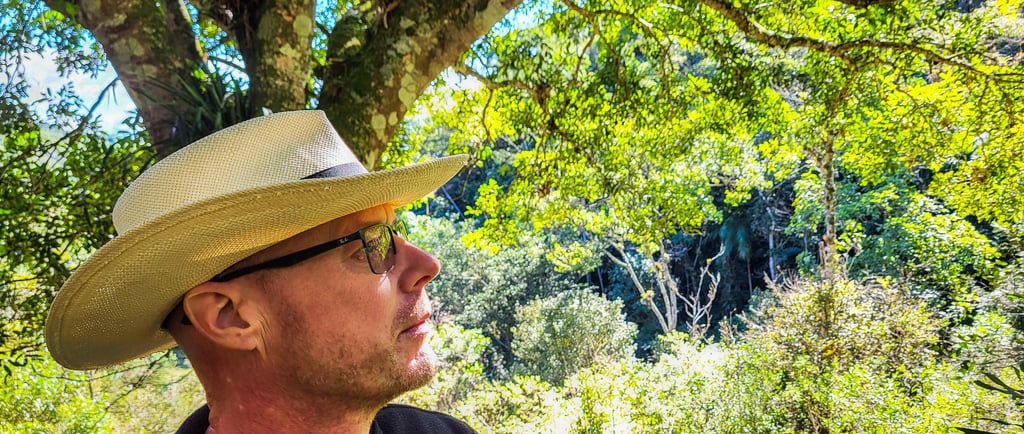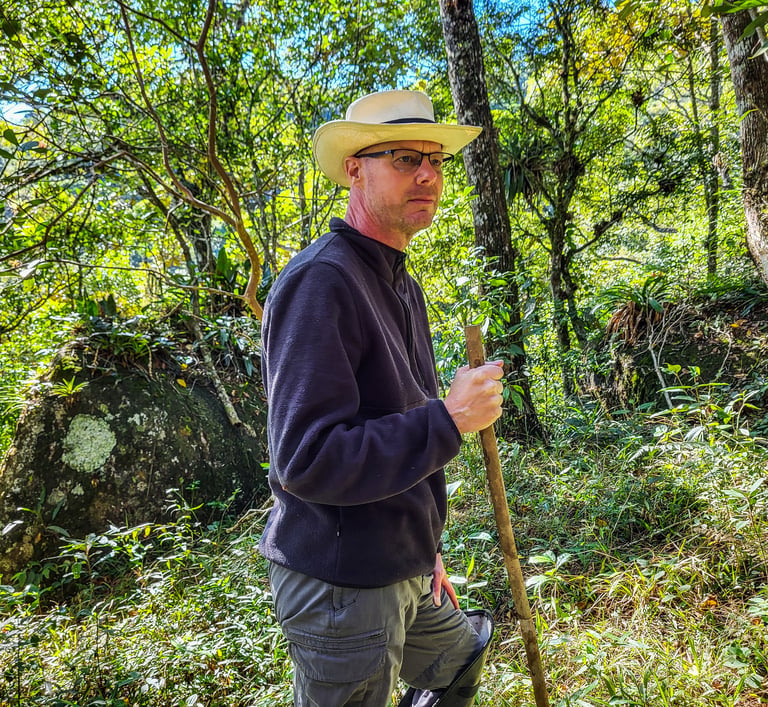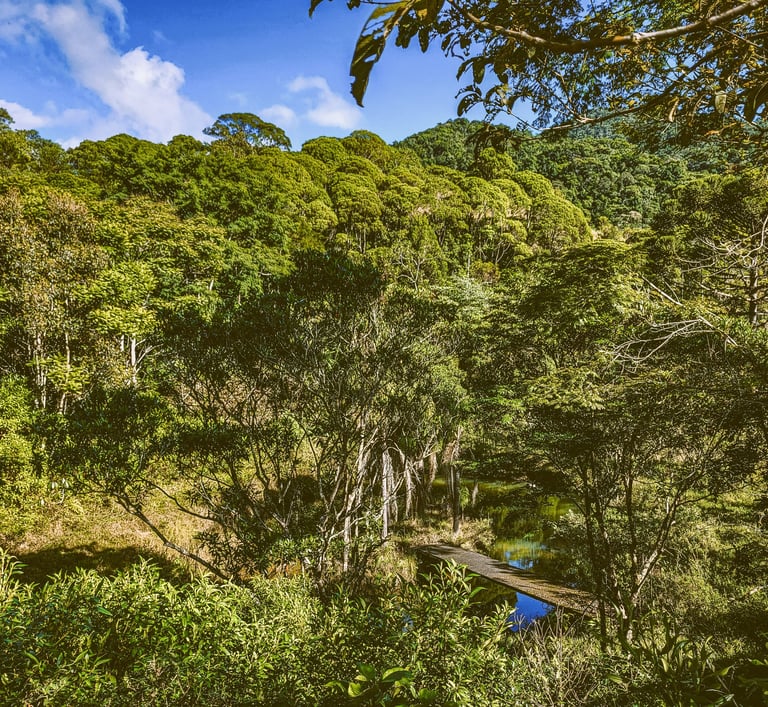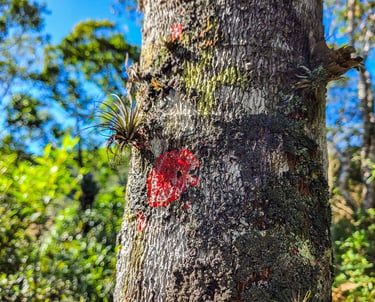Into the Wild: An Unfiltered Forest Experience
Rob Langdon
5 min read


A Different Kind of Adventure
When most people think of travel, they picture beaches, cities, or scenic overlooks. But once in a while, a trip takes a turn off the beaten path—literally. Recently, I had the rare chance to explore a friend's private property nestled beside the Serra do Tabuleiro State Park in Santa Catarina, Brazil. What made this different?
He had just carved a brand-new trail into the forest using nothing but a machete.
No maps. No signs. Just raw, untouched wilderness and the thrill of stepping into nature’s unfiltered core.
This wasn’t just a hike—it was a lesson in presence, in challenge, and in the deep meaning that only wild nature can offer.
The Setting: Serra do Tabuleiro
Serra do Tabuleiro is the largest conservation unit in Santa Catarina, covering more than 90,000 hectares of Atlantic rainforest, mountains, waterfalls, and abundant wildlife. Its biodiversity is astounding—home to jaguars, pumas, howler monkeys, and hundreds of bird species.
But my destination wasn’t within the official park—it bordered it. The property, dense with native forest and steep terrain, shared its essence. In many ways, it was even more wild, as no one had walked this trail before. The machete marks on tree trunks were still fresh.
Into the Wild
Walking behind my friend, machete in hand, I realized this would not be an ordinary day. The trail was barely a path. In many parts, we were stepping over fallen trees, sliding on wet leaves, and ducking under hanging vines.
The forest here is dense and alive, the air thick with humidity and the scent of earth. Sunlight barely pierced the canopy. Every step felt like a conversation with nature—quiet, intimate, and slightly intimidating.
Key Tip: Never go alone into a trail like this. Always have someone who knows the area well.
The Raw Beauty and Challenges of a Wild Trail
As we progressed, I was struck by two things: the beauty of the untouched forest and the challenge of navigating it.
The beauty came in whispers—a tiny orchid blooming on a branch, the rhythmic call of distant birds, the dappled light dancing on moss-covered stones. I felt completely immersed in something sacred.
But the challenge? That came in bruises, scratches, and insect bites that would make a dermatologist cry.
Important Note: Wear long pants, long sleeves, and insect repellent—and reapply often. I didn’t reapply, and the result was dozens of itchy welts on my legs that took a week to fade.
Safety in the Forest: What You Need to Know
The Atlantic forest may be beautiful, but it demands respect. Here’s what I learned—sometimes the hard way.
1. Wear the Right Clothing
Long sleeves and pants: Protect you from thorns, insect bites, and sunburn.
Sturdy boots: Trails can be steep, muddy, and full of hidden roots.
Gaiters or high socks: Essential for snake protection.
Gloves and hat: Good for sun and minor scrapes.
2. Know What Lives There
The Atlantic Forest is home to venomous snakes like the jararaca and coral snake, and occasionally, spiders and scorpions under rocks or fallen logs.
How to Avoid Dangerous Encounters
Watch every step—especially where you place your hands and feet.
Avoid walking barefoot or with open footwear.
Don’t overturn logs or rocks with your bare hands.
Make noise as you walk. It helps snakes sense your presence and retreat.
If bitten, stay calm and seek help immediately—don't try to suck the venom.
Even though we didn’t spot any snakes that day, we did see shed skins and signs that reminded us we weren’t alone.
Physical and Mental Lessons from the Forest
Every part of this trail taught me something.
Physical endurance: Climbing steep, muddy paths was no joke. My thighs burned, my heart raced.
Mindfulness: The silence forced me into presence. No notifications. Just breath and sound.
Respect for nature: The forest doesn’t bend to your will. You adapt, or you leave.
One moment that stuck with me was when we had to cross a creek, slippery stones underfoot and vines overhead. I slipped and fell—not hard, but enough to be reminded that this was not a tourist trail. It was alive, wild, and real.
The Insect Bites
Let’s talk about the bites.
Despite my best efforts with repellent, the forest insects won. My legs were covered in red bumps, especially around the ankles. Some stung, others itched like fire. I looked like I had measles by the end of the day.
What caused them? Probably a mix of mosquitoes, ants, and midges.
Pro Tip: Pack after-bite cream, antihistamines, and don’t scratch, no matter how tempting it is.
These bites weren’t just irritating—they were reminders that I was deep in wild territory, part of something ancient.
Gear Checklist for Raw Forest Hiking
If you’re ever invited to hike a fresh trail like this, don’t go unprepared. Here’s what I recommend bringing:
Waterproof boots with ankle support
Long, light clothing (UV-protective if possible)
Insect repellent with DEET or natural alternatives (citronella, eucalyptus)
Snake Gaiters
Machete or walking stick (for support and clearing vines)
Small first aid kit
Plenty of water and snacks
Navigation tools (even if your friend knows the way)
Emergency whistle and flashlight
Who Should NOT Do a Hike Like This
As thrilling as this was, it’s not for everyone.
Avoid this type of hike if:
You have mobility issues or heart problems
You’re afraid of insects or reptiles
You dislike sweating, mud, or physical discomfort
You aren’t comfortable with zero cellphone signal
You don’t have proper hiking or survival gear
This is not a walk in the park. It's a real, rugged adventure. And that’s what makes it so meaningful.
Why This Was One of the Most Meaningful Trips I’ve Taken
After the hike, sweaty and scratched, I sat on a boulder and looked out over the tree canopy. My legs were itchy, my body sore—but my heart was full.
This trip reminded me of something we often forget:
True travel isn’t always easy or glamorous. Sometimes it’s muddy, bug-bitten, and wild. But it’s real. And that’s what makes it unforgettable.
By walking this untouched trail, I felt like I had connected not just with nature—but with something deep inside myself. It’s easy to coast through life, but when you step off the map, the forest asks you to wake up.
Should You Go?
If you’re adventurous, prepared, and respectful of nature, then yes—absolutely go. Trails like this aren’t found on tourist maps. They are made by hands, footsteps, and courage.
But go safely. Go humbly. Go ready to learn.
The forest will show you things you’ve forgotten how to see.
Exploring the raw, untamed trail beside Serra do Tabuleiro was more than just a hike—it was a journey into the heart of nature and into myself. It reminded me that the most meaningful travel experiences often come when we leave comfort behind and embrace the unknown. Amid the bites, sweat, and challenges, I found clarity, wonder, and connection. For those willing to venture with respect, preparation, and an open heart, the forest offers not just beauty, but transformation.
Share Your Experience
Have you ever ventured deep into a forest trail like this? Did you have encounters with nature—good or bad? Share your story with me or tag me in your own #WildTrailAdventures.
Let’s bring back the real travel stories—where it’s not about comfort, but about connection.





